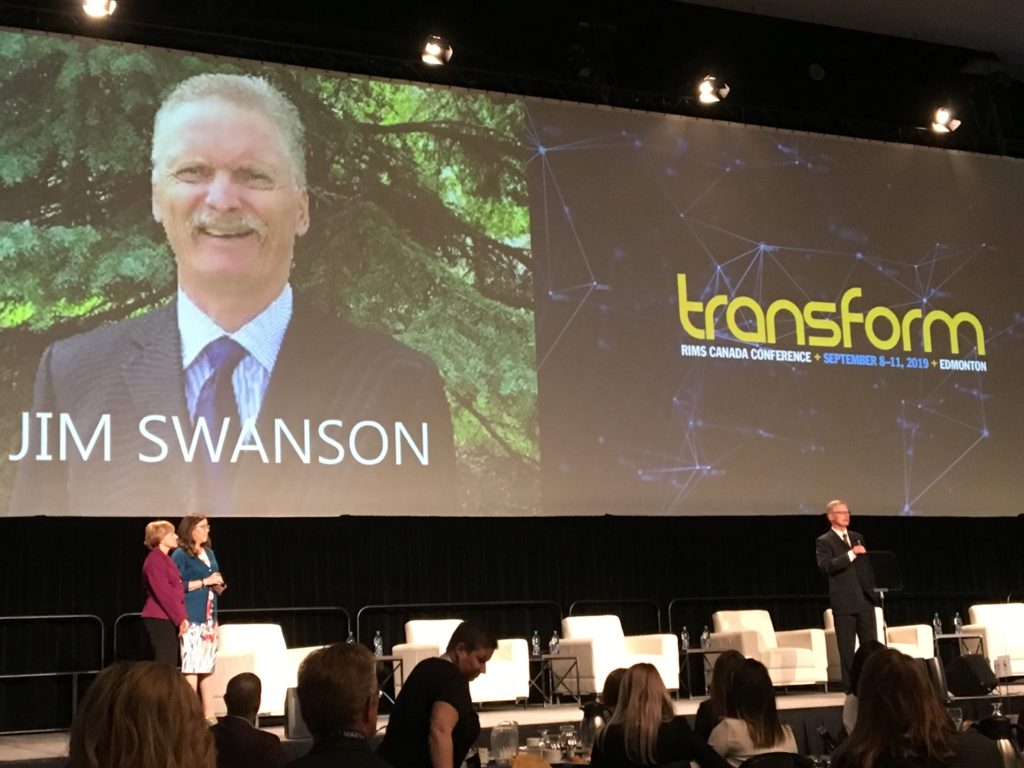EDMONTON — The 2019 RIMS Canada Conference got its green light Monday morning when technology and disruption strategist Shawn Kanungo entered the Edmonton Convention Centre in an ELA, an electronic autonomous shuttle being piloted in Canada. “Transform” is this year’s conference theme and, as emcee, Kanungo emphasized the need for attendees to embrace risk in order to improve their organizations. “Experimentation,” he said, “is the gateway drug to true transformation.”
Ahead of the morning’s keynote, the RIMS Canada Council announced its top honors for accomplishment in the risk management field. For the risk professional earning the highest average mark on the three examinations required to attain the Canadian Risk Management (CRM) designation, the Fred H. Bossons Award was awarded to Ronnie Yuen, underwriting assistant at Starr Technical Risks Canada, Inc.
 In recognition of outstanding contributions to the risk management profession, the 40th annual Donald M. Stuart Award went to Jim Swanson, the now-retired director of insurance and risk management for the Province of Manitoba. During his 30 years with the province, Swanson developed insurance and risk management policies for its 12 departments and 39 agencies. An active RIMS member, Swanson held several positions on the RIMS Manitoba Chapter Board of Directors, including chapter president from 1992 to 1994, and chaired the RIMS Canada Conference three times.
In recognition of outstanding contributions to the risk management profession, the 40th annual Donald M. Stuart Award went to Jim Swanson, the now-retired director of insurance and risk management for the Province of Manitoba. During his 30 years with the province, Swanson developed insurance and risk management policies for its 12 departments and 39 agencies. An active RIMS member, Swanson held several positions on the RIMS Manitoba Chapter Board of Directors, including chapter president from 1992 to 1994, and chaired the RIMS Canada Conference three times.
Women In Leadership
Even the format of the keynote was transformed this year, with a “Women In Leadership” panel taking the place of a traditional single speaker. Lana Cuthbertson of ATB Financial moderated a discussion of gender equality and diversity, highlighted by the personal experiences of five risk leaders: Lynn Oldfield, president and CEO of AIG Canada; Sarah Robson, president and CEO of Marsh Canada Ltd.
; Christine Lithgow, CEO of commercial risk solutions at Aon Canada Risk Solutions; Yvonne Steiner, head of property at Zurich; and Gloria Brosius, director of risk management and insurance at Pinnacle Agriculture Distribution, Inc., and 2019 RIMS president.
One key topic was parental leave, for which all panelists voiced their support. Steiner said that taking leave to raise new children can build critical, transferable skills since it is “a time to truly learn empathy and unimaginable patience.”
Some panelists detailed putting their careers on hold for years as they raised their families. It was during the return to the workforce when some had to overcome more direct cynicism and discrimination. For example, after Lithgow’s six-year absence from the profession, she was courted for roles way below her pay grade and experience level.
“I was being offered junior roles after having been an executive,” Lithgow recalled. “I reminded [interviewers] that it was a baby that dropped from my uterus, not my brain,” she added, receiving the morning’s biggest ovation.
The discussion also explored who comprises the profession in Canada. Oldfield, who is also the outgoing chair of the Insurance Institute of Canada, cited recent research from the organization’s demographics report to demonstrate women’s progress in property and casualty. She said women in Canada now constitute 62% of employees, 52% of management, and 59% of frontline management positions. However, there have been only moderate increases in the past 10 years at the executive leadership level, with 35% in 2017, up from 28% in 2007.
Robson described the pay gap as “another elephant in the room,” with women in full-time positions earning 87 cents of every dollar men earn based on average hourly wage, according to 2018 data from Catalyst.org.
“While I would love to say now is the time to drop the ‘women’ part [of the discussion], I don’t see how we can do that at this stage,” Robson said. “The reality is we need to call out discrepancies and inequalities and highlight the successes in order to promote, challenge and change.
”


